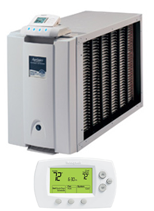
Indoor Air Quality
Poor Indoor Air Quality Can Threaten Your Health
Most people spend over 90% of their time indoors, not knowing that the air they are breathing may be more polluted than the air outside. The Environmental Protection Agency has reported that indoor air pollution levels can be 100 times higher than the air outdoors.
Breathing contaminated air puts the health of you and your family at risk. In fact, the American College of Allergist says that 50% of illnesses are caused or aggravated by polluted indoor air. So take control of your indoor air quality by reducing pollutants that can contribute to headache, lung irritation and fatigue as well as more long-term conditions such as asthma, allergies and infectious diseases.
INDOOR AIR QUALITY FACTS
- People spend 75-90% of their time indoors.
- Exposure to airborne contamination is considerable.
- 50% of all major office buildings have contaminated heating, ventilation and air conditioning systems (HVAC). If not properly maintained, they are a hotbed for growth of molds and bacteria.
- Each person inhales over 3,500 gallons of air each day. Children inhale more particles for their size then adolescents or adults.
- Polluted air causes 94% of all respiratory problems.
- More than 31 million Americans have been diagnosed with asthma, about 1/3 are children under 18.
- About 40,000 dust mites, a common household allergen, can live in one ounce of dust.
- An estimated 10-15% of the entire population may be allergic to cat or dog dander.
- A person sheds up to 700,000 skin flakes per day.
3 TYPES OF INDOOR POLLUTANTS
1. Particulate
Particulates are tiny particles suspended in the air. Common particulates include residential
pollen, dust mites, dust, smoke and dander (skin flakes). Particulate diameters are measured in microns and
range from .001 to 1,000 microns. These dimensions represent the continuum from a few molecules up to the
size where particles can no longer be airborne. Particulates are removed from the air by filtration. Air
filters differ in effectiveness as they can trap different size particulates.
2. Microbials
These are bacteria, germs, viruses, fungi, spores and mold. Although bacteria are small in size and
usually microscopic, they have an amazing ability to do horrible damage to all living organisms including humans.
Many everyday illnesses are also caused by viruses like the common cold or the flu. Microbials are living
organizations that must be killed.
3. Gases
Indoor odors and gases, such as benzene, formaldehyde, chloroform, hydrogen sulfide, ammonia, etc.,
are released from furniture, cabinets, carpets, cleaning chemicals, copy machines, insulation, insect sprays,
hair sprays, etc.




